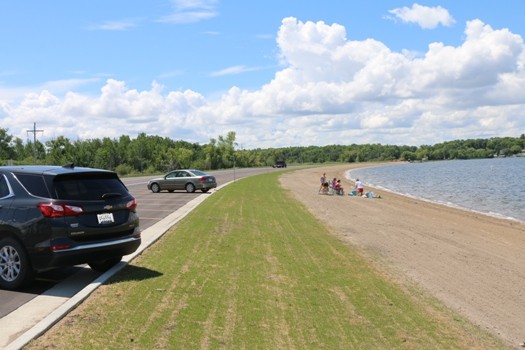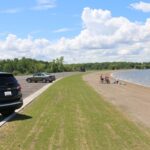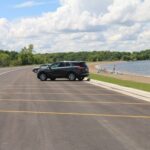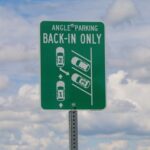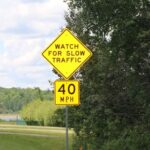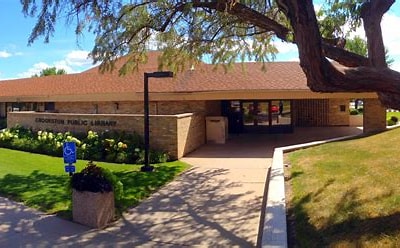Polk County recently finished their reconstruction project on the east shore at Maple Lake. The project expanded the beach, added new grass for picnicking, and plenty of parking for public beachgoers.
The parking area design uses back-in diagonal parking to allow beach users to unload right onto the beach.
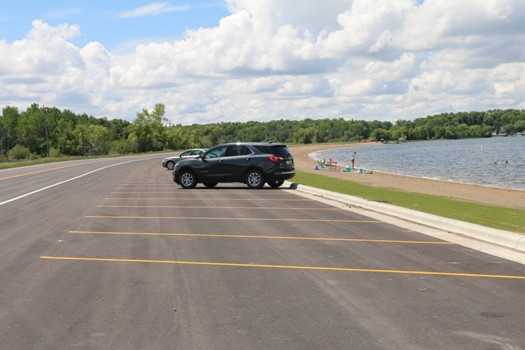 Polk County Engineer Rich Sanders said the old beachfront with a road running between the beach and picnic area created conflict between swimmers and vehicles that the new design eliminates. “What you had was the lake, 10 feet to the old roadway, a 20-foot roadway, and then about 61 feet from the edge of the road to the middle of County Road 10,” said Sanders. “What we did was remove the old road and added sand, so you have about 35 feet of sand and 20 feet of grass. And our parking is back-in diagonal parking along the road.” The reason why they moved the old road was because people were pulling in and driving down the road to either park and picnic, or just to drive through and see who was all here. “You had that conflict between the kids in the water and the adults picnicking and so there was constant traffic going across that roadway between the traffic and people wanting to picnic and swim,” said Sanders. “We got rid of that conflict, so now you don’t have to worry about it. You can come out, picnic in the grass, kids can swim on the beach and use the sand. We put some nice sand out here and dressed it up. “It made the experience of picnicking and swimming at east shore safer.”
Polk County Engineer Rich Sanders said the old beachfront with a road running between the beach and picnic area created conflict between swimmers and vehicles that the new design eliminates. “What you had was the lake, 10 feet to the old roadway, a 20-foot roadway, and then about 61 feet from the edge of the road to the middle of County Road 10,” said Sanders. “What we did was remove the old road and added sand, so you have about 35 feet of sand and 20 feet of grass. And our parking is back-in diagonal parking along the road.” The reason why they moved the old road was because people were pulling in and driving down the road to either park and picnic, or just to drive through and see who was all here. “You had that conflict between the kids in the water and the adults picnicking and so there was constant traffic going across that roadway between the traffic and people wanting to picnic and swim,” said Sanders. “We got rid of that conflict, so now you don’t have to worry about it. You can come out, picnic in the grass, kids can swim on the beach and use the sand. We put some nice sand out here and dressed it up. “It made the experience of picnicking and swimming at east shore safer.”
Sanders said the back-in parking is safer because it allows you to see traffic coming from the north and car doors will create a barrier between kids and the road. “If you look at your typical roadways, we typically have parallel parking in along our roadways,” said Sanders. “So, you have to pull in and parallel park. To do that along a busy street, you almost get out into traffic. With back in diagonal parking, you pull up and back-in instead of pulling forward. Then, as you’re pulling out of the spot is where the safety comes in.” As a driver, you will be able to pull out slowly, see the traffic coming and get into traffic more safely. “Also, if you back-in and open your doors, they are a barrier to the road as well, so people can only walk toward the beach, not towards the road,” added Sanders.
Sanders said safety played a vital role in the design, such as replacing the old single-cable guardrail that no longer met crash safety standards. “We have our normal 12-foot lanes, a nine-foot buffer between the parking lane and the edge of the roadway giving that much more barrier before parking, said Sanders. The parking stalls are 21 feet deep. A typical car is 15 feet long. “You have six feet from the front of the car to the beginning of the stall,” said Sanders. “So, really, you have 15 feet from the front of your car to the edge of the lane. In the past, we had 33 feet from the centerline to the ditch bottom where the single cable guardrail was that doesn’t meet current crash standards. So, we got rid of that guardrail. You can back in, lift open your trunk, throw your chairs and beach blanket on the grass, picnic right behind your vehicle if you want, and your kids can go swimming along the beach.”
Minnesota Statute says all rural county road speed limits are 55 miles per hour unless a state speed study determines an appropriate increase or decrease. Sanders said the county did the project intending to get the speed reduced to 40 miles per hour and has placed suggested speed signs at both ends of the east shore beach. The county would be adding flashing radars set at 40 miles per hour and be requesting a speed study from the Minnesota Department of Transportation (MNDOT). “We’re hoping that we can get the traffic along this stretch during the summer to reduce its speed down to 40 miles per hour. We’ll do this for a couple of summers, and then we’ll have MNDOT come in and study the area to see if we can’t get it posted regulatory for that 40 MPH.”
Sanders encourages the public to go to the east shore to enjoy the new beach experience. “Remember, you need to back in. If you pull in, you’re making it harder on yourself and more unsafe that way,” said Sanders. Backing in is the safest way. We have signs up every couple hundred feet showing you how to back in, and we’ll also have it on our Facebook page how to back-in. Hopefully, everybody will enjoy this new project.”

